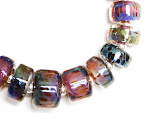I had the amazing opportunity to submit to
Thompson Enamel a few pieces of my work using
Hadar's copper clay for testing by Bill Helwig. Unfortunately my inexperience with enameling created a few issues - thus only a couple pieces were of acceptable quality to be used.
My failure, however, proves to be an excellent learning experience for all of us who may be interested in pursuing enameling with this new and exciting new medium. I have transcribed some of the notes to share with you so we may all be better prepared when we decide to try again!
These are the overall assessment:
• Hadar's clay can be enameled but certain considerations and preparations must be made
• Metal clay in general is a porous material so the surface must be worked so it's highly compressed
• Methods to compress the material include – burnish, chase, engrave, and/or tumble with steel needles
• Metal must be of a uniform thickness
• There should be an edge for the enamel to stop against
• Recessed areas should be 0.012 - 0.016 inch / 0.3 - 0.4mm
• No undercuts
• If a mirror finish cannot be achieve, use gold/silver foil with transparent or use opaque enamel

Packed with 2020, 2510, and 2110. Dried overnight on top of a furnace and fired for 3 minutes at 1450F.


This piece was tested for enameling on the back since the surface turned out to be more appropriate (compressed and mirror finished) - 2020 was dry sifted and fired for 3 minutes at 145F, some red copper oxide appeared.

This piece was not used in the enamel testing because the outside edge of the inner form has a second depth which could create a problem.

This piece was not used in the enamel testing because the crude surface would show.

This piece was not used in the enamel testing because for the basse taille design to show, the metal must be compressed and the enamel clean and thin. Also the C and S curves were too deep and of two different depths.

This piece was not used in the enamel testing because it was too deep.
I hope you find this information helpful.




















